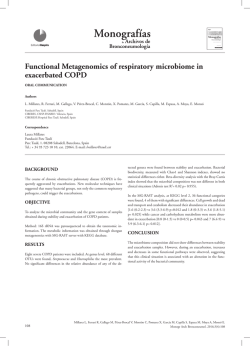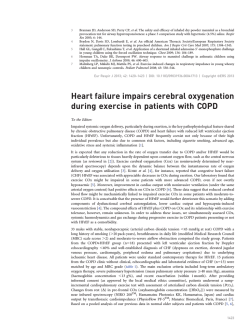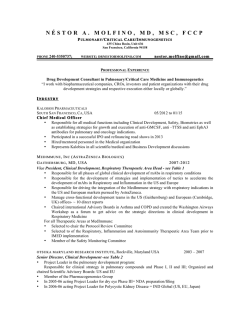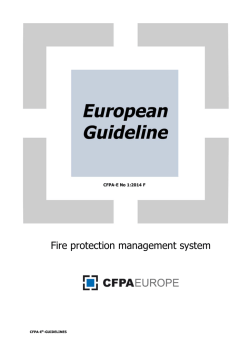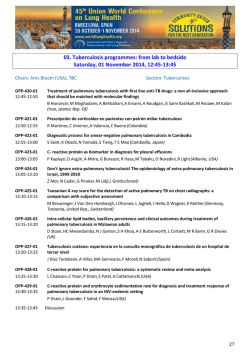
NICE | Provider of national guidance and advice to improve health
Quick reference guide Issue date: June 2010 Chronic obstructive pulmonary disease Management of chronic obstructive pulmonary disease in adults in primary and secondary care This is an update of NICE clinical guideline 12 NICE clinical guideline 101 Developed by the National Clinical Guideline Centre for Acute and Chronic Conditions COPD in primary and secondary care About this booklet This is a quick reference guide that summarises the recommendations NICE has made to the NHS in ‘Chronic obstructive pulmonary disease in adults in primary and secondary care (update)’ (NICE clinical guideline 101). This guidance is an update of ‘Chronic obstructive pulmonary disease in adults in primary and secondary care’ (published February 2004). This booklet includes the recommendations developed in 2004 and the new recommendations from the 2010 update. New recommendations have been added on spirometry, assessment of prognostic factors, and to the section on inhaled therapy (which now incorporates the previously separate sections on inhaled bronchodilators, inhaled corticosteroids and inhaled combination therapy). Who should read this booklet? This quick reference guide is for consultants, GPs, nurses and other staff who care for adults with chronic obstructive pulmonary disease. Who wrote the guideline? The guideline was developed by the National Clinical Guideline Centre for Acute and Chronic Conditions. The Guideline Centre worked with a group of healthcare professionals (including consultants, GPs and nurses), patients and carers, and technical staff, who reviewed the evidence and drafted the recommendations. The recommendations were finalised after public consultation. For more information on how NICE clinical guidelines are developed, go to www.nice.org.uk Where can I get more information about the guideline? The NICE website has the recommendations in full, reviews of the evidence they are based on, a summary of the guideline for patients and carers, and tools to support implementation (see page 20 for more details). © National Institute for Health and Clinical Excellence, 2010. All rights reserved. This material may be freely reproduced for educational and not-for-profit purposes. No reproduction by or for commercial organisations, or for commercial purposes, is allowed without the express written permission of NICE. NICE clinical guidelines are recommendations about the treatment and care of people with specific diseases and conditions in the NHS in England and Wales. This guidance represents the view of NICE, which was arrived at after careful consideration of the evidence available. Healthcare professionals are expected to take it fully into account when exercising their clinical judgement. However, the guidance does not override the individual responsibility of healthcare professionals to make decisions appropriate to the circumstances of the individual patient, in consultation with the patient and/or guardian or carer, and informed by the summary of product characteristics of any drugs they are considering. Implementation of this guidance is the responsibility of local commissioners and/or providers. Commissioners and providers are reminded that it is their responsibility to implement the guidance, in their local context, in light of their duties to avoid unlawful discrimination and to have regard to promoting equality of opportunity. Nothing in this guidance should be interpreted in a way that would be inconsistent with compliance with those duties. COPD in primary and secondary care Contents Contents Key priorities for implementation 4 Key to terms 5 Diagnosing COPD 6 Managing stable COPD 8 Managing exacerbations of COPD 17 Further information 20 Introduction An estimated 3 million people have chronic obstructive pulmonary disease (COPD) in the UK1. Most people are not diagnosed until they are in their fifties. COPD is predominantly caused by smoking and is characterised by airflow obstruction that is not fully reversible. The airflow obstruction does not change markedly over several months but is usually progressive in the long term. Exacerbations often occur, when there is a rapid and sustained worsening of the patient’s symptoms beyond normal day-to-day variations. There is no single diagnostic test for COPD. Diagnosis relies on a combination of history, physical examination and confirmation of airflow obstruction using spirometry. Person-centred care Treatment and care should take into account people’s individual needs and preferences. Good communication is essential, supported by evidence-based information, to allow people to reach informed decisions about their care. Follow advice on seeking consent from the Department of Health or Welsh Assembly Government if needed. If the person agrees, families and carers should have the opportunity to be involved in decisions about treatment and care. 1 Healthcare Commission (2006) Clearing the air: a national study of chronic obstructive pulmonary disease. London: Healthcare Commission. NICE clinical guideline 101 Quick reference guide 3 COPD in primary and secondary care Key priorities for implementation Key priorities for implementation Diagnose COPD ● A diagnosis of COPD should be considered in patients over the age of 35 who have a risk factor (generally smoking) and who present with exertional breathlessness, chronic cough, regular sputum production, frequent winter ‘bronchitis’ or wheeze. ● The presence of airflow obstruction should be confirmed by performing post-bronchodilator spirometry. All health professionals involved in the care of people with COPD should have access to spirometry and be competent in the interpretation of the results. Stop smoking ● Encouraging patients with COPD to stop smoking is one of the most important components of their management. All COPD patients still smoking, regardless of age, should be encouraged to stop, and offered help to do so, at every opportunity. Promote effective inhaled therapy ● In people with stable COPD who remain breathless or have exacerbations despite use of short-acting bronchodilators as required, offer the following as maintenance therapy: – if forced expiratory volume in 1 second (FEV1) ≥ 50% predicted: either long-acting beta2 agonist (LABA) or long-acting muscarinic antagonist (LAMA) – if FEV1 < 50% predicted: either LABA with an inhaled corticosteroid (ICS) in a combination inhaler, or LAMA. ● Offer LAMA in addition to LABA + ICS to people with COPD who remain breathless or have exacerbations despite taking LABA + ICS, irrespective of their FEV1. Provide pulmonary rehabilitation for all who need it ● Pulmonary rehabilitation should be made available to all appropriate people with COPD including those who have had a recent hospitalisation for an acute exacerbation. Use non-invasive ventilation 4 ● Non-invasive ventilation (NIV) should be used as the treatment of choice for persistent hypercapnic ventilatory failure during exacerbations not responding to medical therapy. It should be delivered by staff trained in its application, experienced in its use and aware of its limitations. ● When patients are started on NIV, there should be a clear plan covering what to do in the event of deterioration and ceilings of therapy should be agreed. NICE clinical guideline 101 Quick reference guide COPD in primary and secondary care Key priorities for implementation Manage exacerbations ● The frequency of exacerbations should be reduced by appropriate use of inhaled corticosteroids and bronchodilators, and vaccinations. ● The impact of exacerbations should be minimised by: – giving self-management advice on responding promptly to the symptoms of an exacerbation – starting appropriate treatment with oral steroids and/or antibiotics – use of non-invasive ventilation when indicated – use of hospital-at-home or assisted-discharge schemes. Ensure multidisciplinary working ● COPD care should be delivered by a multidisciplinary team. Key to terms ATS: American Thoracic Society BMI: Body mass index BODE: Body mass index, airflow obstruction, dyspnoea and exercise capacity COPD: Chronic obstructive pulmonary disease ERS: European Respiratory Society FEV1: Forced expiratory volume in 1 second FVC: Forced vital capacity GOLD: Global Initiative for Chronic Obstructive Lung Disease ICS: Inhaled corticosteroid NICE clinical guideline 101 LABA: LAMA: LTOT: MRC: NIV: PaO2: SABA: SAMA: SaO2: TLCO: Long-acting beta2 agonist Long-acting muscarinic antagonist Long-term oxygen therapy Medical Research Council Non-invasive ventilation Partial pressure of oxygen in arterial blood Short-acting beta2 agonist Short-acting muscarinic antagonist Oxygen saturation of arterial blood Carbon monoxide lung transfer factor Quick reference guide 5 COPD in primary and secondary care Diagnosing COPD Diagnosing COPD Consider a diagnosis of COPD for people who are: ● over 35, and ● smokers or ex-smokers, and ● have any of these symptoms: – exertional breathlessness – chronic cough – regular sputum production – frequent winter ‘bronchitis’ – wheeze ● and do not have clinical features of asthma: – chronic unproductive cough – significantly variable breathlessness – night-time wakening with breathlessness and/or wheeze – significant diurnal or day-to-day variability of symptoms Ask about the following factors where COPD is suspected: ● ● ● ● ● ● ● ● weight loss effort intolerance waking at night ankle swelling fatigue occupational hazards chest pain haemoptysis Perform initial diagnostic evaluation if COPD seems likely: ● ● ● ● post-bronchodilator spirometry (record absolute and percentage of predicted values) chest X-ray to exclude other diagnoses (investigate abnormalities using a CT scan) full blood count to identify anaemia or polycythaemia body mass index (BMI) calculation Assess severity (see table 1) Consider alternative diagnoses in older people without typical symptoms of COPD and FEV1 / FVC ratio < 0.7, and younger people with symptoms of COPD and FEV1 / FVC ratio ≥ 0.7 Spirometric reversibility testing is not usually necessary as part of the diagnostic process or to plan initial therapy If no doubt, diagnose COPD and start treatment (see page 9) If still in doubt, make a provisional diagnosis and start empirical treatment (see page 9) Reassess diagnosis in view of response to treatment: ● ● ● Clinically significant COPD is not present if FEV1 and FEV1 / FVC ratio return to normal with drug therapy Asthma may be present if: – there is a > 400 ml response to bronchodilators – serial peak flow measurements show significant (≥ 20%) diurnal or day-to-day variability – there is a > 400 ml response to 30 mg prednisolone daily for 2 weeks Refer for more detailed investigations if needed (see page 14) For all people with diagnosed COPD: ● ● 6 Highlight the diagnosis of COPD in the notes and computer database (using Read codes) Record the results of spirometric tests at diagnosis – absolute and percentage of predicted NICE clinical guideline 101 Quick reference guide COPD in primary and secondary care Diagnosing COPD Spirometry ● Consider spirometry in people with chronic bronchitis. ● All health professionals involved in the care of people with COPD should have access to spirometry and be able to interpret the results. ● Any healthcare worker with up-to-date training may perform spirometry. ● Spirometry services should be supported by quality control processes. ● Use ERS 1993 reference values2 but be aware these may lead to underdiagnosis in older people and are not applicable in black and Asian populations†. Determining disease severity ● Disability in COPD can be poorly reflected in the FEV1. A more comprehensive assessment also includes: – degree of airflow obstruction and disability – frequency of exacerbations – prognostic factors such as breathlessness (assessed using the Medical Research Council [MRC] scale), carbon monoxide lung transfer factor (TLCO), health status, exercise capacity, BMI, partial pressure of oxygen in arterial blood (PaO2) and cor pulmonale. ● Investigate symptoms that seem disproportionate to the spirometric impairment using a CT scan or TLCO testing. ● Calculate the BODE index (BMI, airflow obstruction, dyspnoea and exercise capacity) to assess prognosis (where the component information is currently available). ● Assess severity of airflow obstruction using table 1. Table 1. Severity of airflow obstruction NICE clinical guideline 12 (2004) ATS/ERS 20043 GOLD 20084 NICE clinical guideline 101 (2010) Postbronchodilator FEV1/FVC FEV1 % predicted Postbronchodilator Postbronchodilator Postbronchodilator < 0.7 ≥ 80% Mild Stage 1 – Mild Stage 1 – Mild* < 0.7 50–79% Mild Moderate Stage 2 – Moderate Stage 2 – Moderate < 0.7 30–49% Moderate Severe Stage 3 – Severe Stage 3 – Severe < 0.7 < 30% Severe Very severe Stage 4 – Very severe** Stage 4 – Very severe** * Symptoms should be present to diagnose COPD in people with mild airflow obstruction Or FEV1 < 50% with respiratory failure ATS, American Thoracic Society; ERS, European Respiratory Society; FVC, forced vital capacity; GOLD, Global Initiative for Chronic Obstructive Lung Disease ** 2 Quanjer PH, Tammeling GJ, Cotes JE et al. (1993) Lung volumes and forced ventilatory flows. Report Working Party Standardization of Lung Function Tests, European Community for Steel and Coal. Official Statement of the European Respiratory Society. European Respiratory Journal (Suppl) 16: 5–40. 3 Celli BR, MacNee W (2004) Standards for the diagnosis and treatment of patients with COPD: a summary of the ATS/ERS position paper. European Respiratory Journal 23(6): 932–46. 4 Global Initiative for Chronic Obstructive Lung Disease (GOLD) (2008) Global strategy for the diagnosis, management, and prevention of chronic obstructive pulmonary disease. † Definitive spirometry reference values are not currently available for all ethnic populations. The GDG was aware of ongoing research in this area. NICE clinical guideline 101 Quick reference guide 7 COPD in primary and secondary care Managing stable COPD Managing stable COPD Smoking cessation ● Record a smoking history, including pack years smoked, for everyone with COPD. ● All people with COPD who still smoke, regardless of age, should be encouraged to stop, and offered help to do so at every opportunity. ● Offer nicotine replacement therapy, varenicline5 or bupropion (unless contraindicated) combined with a support programme to optimise quit rates6: – varenicline is recommended within its licensed indications as an option for smokers who have expressed a desire to quit smoking* – varenicline should normally be prescribed only as part of a programme of behavioural support*. [*These recommendations are from ‘Varenicline for smoking cessation’ (NICE technology appraisal guidance 123).] Treatment ● 5 6 8 Assess the effectiveness of inhaled therapy and theophylline using lung function tests and other measures such as: – improvements in symptoms – activities of daily living – exercise capacity – speed of symptom relief (short-acting bronchodilators only). See ‘Varenicline for smoking cessation’ (NICE technology appraisal guidance 123). See ‘Smoking cessation services’ (NICE public health guidance 10). NICE clinical guideline 101 Quick reference guide COPD in primary and secondary care Managing stable COPD Inhaled therapy Breathlessness and/or exercise limitation Exacerbations or persistent breathlessness SABA or SAMA as required* FEV1 ≥ 50% LABA FEV1 < 50% LAMA** Offer LAMA in preference to regular SAMA four times a day LABA + ICS in a combination inhaler Consider LABA + LAMA if ICS declined or not tolerated LAMA** Offer LAMA in preference to regular SAMA four times a day LABA + ICS in a combination inhaler Consider LABA + LAMA if ICS declined or not tolerated LAMA + LABA + ICS Persistent exacerbations or breathlessness Offer therapy Consider therapy ● Choose a drug based on the person’s symptomatic response and preference, the drug’s side effects, potential to reduce exacerbations and cost. ● Do not use oral corticosteroid reversibility tests to identify patients who will benefit from inhaled corticosteroids. ● Be aware of the potential risk of developing side effects (including non-fatal pneumonia) in people with COPD treated with inhaled corticosteroids and be prepared to discuss this with patients. * SABA as required may continue at all stages; ** Discontinue SAMA. SABA, short-acting beta2 agonist; SAMA, short-acting muscarinic antagonist. NICE clinical guideline 101 Quick reference guide 9 COPD in primary and secondary care Managing stable COPD Delivery systems Inhalers ● ● ● Spacers ● ● ● Nebulisers ● ● ● ● Hand-held devices are usually best, with a spacer if appropriate If a person cannot use a particular device, try another Teach technique before prescribing and check regularly Ensure the spacer is compatible with the inhaler Individuals should make single actuations of the inhaler into the spacer, and inhale as soon as possible, repeating as needed. Tidal breathing is as effective as single breaths Do not clean spacers more than once a month. Clean with water and washing-up liquid and allow to air dry Consider a nebuliser for people with distressing or disabling breathlessness despite maximum therapy with inhalers Assess the individual and/or carer’s ability to use the nebuliser before prescribing and arrange appropriate support and maintenance of equipment Allow the patient to choose either a facemask or mouthpiece where possible Continue nebuliser treatment only if there is an improvement in symptoms, daily living activities, exercise capacity or lung function Oral therapy Corticosteroids ● Maintenance use of oral corticosteroid therapy in COPD is not normally recommended. ● Some people with advanced COPD may need maintenance oral corticosteroids if treatment cannot be stopped after an exacerbation. Keep the dose as low as possible, monitor for osteoporosis and offer prophylaxis. Theophylline ● Offer only after trials of short- and long-acting bronchodilators or to people who cannot use inhaled therapy. ● Theophylline can be used in combination with beta2 agonists and muscarinic antagonists. ● Take care when prescribing to older people because of pharmacokinetics, comorbidities and interactions with other medications. ● Reduce theophylline dose if macrolide or fluroquinolone antibiotics (or other drugs known to interact) are prescribed to treat an exacerbation. Mucolytic therapy ● Consider in people with a chronic productive cough and continue use if symptoms improve. ● Do not routinely use to prevent exacerbations. Treatments that are not recommended: ● Anti-oxidant therapy (alpha-tocopherol and beta-carotene supplements). 10 ● Anti-tussive therapy. ● Prophylactic antibiotic therapy. NICE clinical guideline 101 Quick reference guide COPD in primary and secondary care Managing stable COPD Oxygen therapy Long-term oxygen therapy ● Assess the need for oxygen therapy in people with any of the following: – peripheral oedema – very severe airflow obstruction – a raised jugular venous pressure (FEV1 less than 30% predicted) – oxygen saturations less than or equal to – cyanosis 92% breathing air. – polycythaemia ● Consider assessment for people with severe airflow obstruction (FEV1 30–49% predicted). ● Assess by measuring arterial blood gases on two occasions at least 3 weeks apart in people with confirmed, stable COPD who are receiving optimum medical management. ● Offer long-term oxygen therapy (LTOT) to people with PaO2 less than 7.3 kPa when stable, or greater than 7.3 and less than 8 kPa when stable and: – secondary polycythaemia or – peripheral oedema or – nocturnal hypoxaemia or – pulmonary hypertension. ● Be aware that inappropriate oxygen therapy in people with COPD may cause respiratory depression. ● All healthcare settings should have a pulse oximeter to ensure all people needing LTOT are identified and to review people receiving LTOT at least once a year. ● People receiving LTOT should breathe supplemental oxygen for at least 15 hours a day. If they smoke, warn them about the risk of fire and explosion. ● Use oxygen concentrators to provide the fixed supply for LTOT at home. ● Refer people who are hypercapnic or acidotic on LTOT to a specialist centre for consideration of longterm NIV. Ambulatory oxygen therapy ● Offer ambulatory oxygen to people already on LTOT who want to use oxygen outside the home, following assessment by a specialist. ● Consider in motivated individuals who have exercise desaturation and PaO2 less than or equal to 7.3 kPa and whose exercise capacity and/or breathlessness improve with oxygen. Short-burst oxygen therapy ● Consider short-burst oxygen therapy (from cylinders) only for episodes of severe breathlessness not relieved by other treatments and continue only if breathlessness improves. NICE clinical guideline 101 Quick reference guide 11 12 NICE clinical guideline 101 Cor pulmonale Frequent exacerbations Breathlessness and exacerbations ● ● ● ● ● ● ● ● ● ● ● ● ● ● ● ● ● Consider in people who have peripheral oedema, a raised venous pressure, a systolic parasternal heave, a loud pulmonary second heart sound Exclude other causes of peripheral oedema Perform pulse oximetry, ECG and echocardiogram if features of cor pulmonale Assess need for LTOT Treat oedema with diuretic Angiotensin-converting enzyme inhibitors, calcium channel blockers, alpha-blockers are not recommended Digoxin may be used where there is atrial fibrillation Optimise inhaled therapy (see page 9) Offer vaccinations and prophylaxis (see page 16) Give self-management advice (see page 17) Consider osteoporosis prophylaxis for people requiring frequent oral corticosteroids Manage breathlessness and exercise limitation with inhaled therapy (see page 9) For exacerbations or persistent breathlessness: – use long-acting bronchodilators or LABA + ICS (see page 9) – consider adding theophylline if still symptomatic Offer pulmonary rehabilitation to all suitable people (see page 16) Refer patients who are breathless, have a single large bulla on a CT scan and an FEV1 less than 50% predicted for consideration of bullectomy Refer people with severe COPD for consideration of lung volume reduction surgery if they remain breathless with marked restrictions of their activities of daily living, despite maximal medical therapy (including rehabilitation), and meet all of the following: – FEV1 greater than 20% predicted – PaCO2 less than 7.3 kPa – upper lobe predominant emphysema – TLCO greater than 20% predicted Consider referring people with severe COPD for assessment for lung transplantation if they remain breathless with marked restrictions of their activities of daily living despite maximal medical therapy. Considerations include: – age – FEV1 – PaCO2 – homogeneously distributed emphysema on CT scan – elevated pulmonary artery pressures with progressive deterioration – comorbidities – local surgical protocols Assess symptoms or condition and manage as described below Managing symptoms and conditions in stable COPD COPD in primary and secondary care Managing stable COPD Quick reference guide NICE clinical guideline 101 8 ● ● Chronic productive cough Anxiety and depression ● Palliative setting Opioids should be used when appropriate for the palliation of breathlessness in people with end-stage COPD unresponsive to other medical therapy Use benzodiazepines, tricyclic antidepressants, major tranquillisers and oxygen to treat breathlessness Provide access to multidisciplinary palliative care teams and hospices Offer referral to a specialist centre to discuss the clinical management of this condition Alpha-1 antitrypsin replacement therapy is not recommended Screen for anxiety and depression using validated tools in people who: – are hypoxic – are severely breathless or – have recently been seen or treated at a hospital for an exacerbation Refer to ‘Depression with a chronic physical health problem’ (NICE clinical guideline 91). Consider mucolytic therapy (see page 10) Refer for dietetic advice (see page 14) Offer nutritional supplements if the BMI is low8 Pay attention to weight changes in older patients (especially > 3 kg) Assess for appropriate oxygen (see page 11) Consider referral for assessment for long-term domiciliary NIV therapy See ‘Nutrition support in adults’ (NICE clinical guideline 32). ● ● ● ● Alpha-1 antitrypsin deficiency ● ● ● ● ● ● Abnormal BMI Respiratory failure COPD in primary and secondary care Managing stable COPD Quick reference guide 13 COPD in primary and secondary care Managing stable COPD Multidisciplinary working ● COPD care should be delivered by a multidisciplinary team that includes respiratory nurse specialists. When defining the team’s activity consider identifying people at risk of exacerbation and providing care to prevent emergency admissions, and providing education and exercise advice. ● Patients who are referred do not always have to be seen by a respiratory physician. Consider referral to a specialist department, as shown in table 2. Table 2. Referral to other health professionals and agencies Physiotherapy To teach people with excessive sputum how to use positive expiratory pressure masks and active cycle of breathing techniques Dietetic advice People with BMI that is high, low or changing over time Occupational therapy People who need help with activities of daily living Social services People who are disabled by COPD Multidisciplinary palliative care teams People with end-stage COPD and their families and carers Referral for specialist advice Referral for advice, specialist investigations or treatment may be appropriate at any stage of disease, not just for people who are severely disabled. ● Possible reasons for referral include: ● ● ● ● ● ● ● ● 14 diagnostic uncertainty suspected severe COPD the individual requests a second opinion onset of cor pulmonale assessment for oxygen therapy, long-term nebuliser therapy or oral corticosteroid therapy bullous lung disease rapid decline in FEV1 assessment for pulmonary rehabilitation NICE clinical guideline 101 ● ● ● ● ● ● assessment for lung volume reduction surgery or lung transplantation dysfunctional breathing onset of symptoms under 40 years or a family history of alpha-1 antitrypsin deficiency symptoms disproportionate to lung function deficit frequent infections haemoptysis. Quick reference guide COPD in primary and secondary care Managing stable COPD Follow-up and review ● Review people with mild or moderate COPD at least once a year and those with very severe COPD at least twice a year. Cover the assessments and measurements in table 3. ● People with stable severe COPD do not normally need regular hospital review, but there should be locally agreed mechanisms to allow rapid hospital assessment when necessary. ● People requiring interventions such as long-term NIV should be reviewed regularly by specialists. Table 3. Follow-up of people with COPD in primary care Mild, moderate or severe airflow obstruction (stages 1–3) Assess: Smoking status and desire to quit ● Adequacy of symptom control: – breathlessness – exercise tolerance – estimated exacerbation frequency ● Presence of complications ● Effects of each drug treatment ● Inhaler technique ● Need for referral to specialist and therapy services ● Need for pulmonary rehabilitation Very severe airflow obstruction (stage 4) Assess: Smoking status and desire to quit ● Adequacy of symptom control: – breathlessness – exercise tolerance – estimated exacerbation frequency ● Presence of cor pulmonale ● Need for LTOT ● Nutritional state ● Presence of depression ● Effects of each drug treatment ● Inhaler technique ● Need for social services and occupational therapy input ● Need for referral to specialist and therapy services ● Need for pulmonary rehabilitation ● ● Measure: ● FEV1 and FVC ● BMI ● MRC dyspnoea score Measure: ● FEV1 and FVC ● BMI ● MRC dyspnoea score ● Oxygen saturation of arterial blood (SaO2) NICE clinical guideline 101 Quick reference guide 15 COPD in primary and secondary care Managing stable COPD Other management issues Pulmonary rehabilitation ● ● ● ● ● Fitness for general surgery ● ● ● ● Patient education ● ● ● Outline the commitment required for pulmonary rehabilitation and the consequent benefits to people with COPD Offer to all appropriate people with COPD, including those who have had a recent hospitalisation for an exacerbation and those who consider themselves functionally disabled by COPD (usually MRC grade 3 and above) Pulmonary rehabilitation is not suitable for people who cannot walk, have unstable angina or who have had a recent myocardial infarction Tailor the programme to individual needs, and include physical training, disease education, and nutritional, psychological and behavioural intervention Hold pulmonary rehabilitation sessions at a practical time in a conveniently located, accessible building to increase concordance The ultimate clinical decision to proceed with surgery should rest with a consultant anaesthetist and consultant surgeon It should take account of the person’s comorbidities, functional status and the necessity of surgery Do not use lung function as the sole assessment criterion. Use composite assessment tools such as the ASA scoring system to predict risk If time permits, optimise the patient’s medical management before surgery. This might include pulmonary rehabilitation Education packages should take account of the different needs at different stages of the disease Asthma education packages are not suitable for people with COPD Inform people with moderate and severe COPD about NIV and its benefits and limitations Vaccinations ● Offer pneumococcal vaccination and an annual influenza vaccination7 as recommended by the Chief Medical Officer Travel and leisure advice ● Assess people who are planning air travel and use LTOT or have FEV1 less than 50% predicted using British Thoracic Society recommendations Inform people with bullous disease of the increased risk of pneumothorax during air travel Scuba diving is not generally recommended for people with COPD. Advise people with queries to take specialist advice ● ● 7 For further information about prophylaxis and treatment of influenza see 'Oseltamivir, amantadine (review) and zanamivir for the prophylaxis of influenza' (NICE technology appraisal guidance 158) and 'Amantadine, oseltamivir and zanamivir for the treatment of influenza' (NICE technology appraisal guidance 168). 16 NICE clinical guideline 101 Quick reference guide COPD in primary and secondary care Managing exacerbations of COPD Managing exacerbations of COPD Self-management ● Encourage people at risk of having an exacerbation to respond quickly to the symptoms of an exacerbation by: – starting oral corticosteroid therapy (unless contraindicated) if increased breathlessness interferes with activities of daily living – starting antibiotic therapy if their sputum is purulent – adjusting bronchodilator therapy to control symptoms. ● Give people at risk of exacerbations a course of antibiotic and corticosteroid tablets to keep at home. Monitor the use of these drugs and advise people to contact a healthcare professional if their symptoms do not improve. Assessing the need for hospital treatment ● Use table 4 to help decide whether to manage an individual in hospital or at home. Take into account the person’s preference. Table 4. Factors to consider when deciding where to manage exacerbations Treat at home? Treat in hospital? Able to cope at home Yes No Breathlessness Mild Severe General condition Good Poor/deteriorating Level of activity Good Poor/confined to bed Cyanosis No Yes Worsening peripheral oedema No Yes Level of consciousness Normal Impaired Already receiving LTOT No Yes Social circumstances Good Living alone/not coping Acute confusion No Yes Rapid rate of onset No Yes Significant comorbidity (particularly cardiac disease and insulin-dependent diabetes) No Yes SaO2 < 90% No Yes Changes on chest X-ray No Present Arterial pH level ≥ 7.35 < 7.35 Arterial PaO2 ≥ 7 kPa < 7 kPa NICE clinical guideline 101 Quick reference guide 17 18 NICE clinical guideline 101 Sputum microscopy and culture if purulent Blood cultures if pyrexial ● ● Full blood count and urea and electrolytes ● Theophylline level at admission (if person is on theophylline) Electrocardiogram ● ● Chest X-ray ● Investigations ● Arterial blood gases (or oxygen saturation if facilities are not available) and note inspired oxygen concentration Decide where to manage (see table 4) Home Use pulse oximetry if the exacerbation is severe Establish on optimal therapy Arrange multidisciplinary assessment if necessary Give clear instructions about correct use of medications (including oxygen) and stopping corticosteroid therapy. Ensure patients are aware of the optimum duration of treatment and the adverse effects of prolonged oral corticosteroid therapy ● ● ● Monitor recovery ● Arrange appropriate review ● Investigations ● Sputum culture is not normally recommended Offer prednisolone 30 mg daily for 7–14 days (there is no advantage in prolonging therapy) ● Hospital Give oral antibiotics if sputum is purulent or there are clinical signs of pneumonia: − use an aminopenicillin, a macrolide or tetracycline and/or follow local microbiology guidance − review antibiotic treatment when culture results are available ● Initial management ● Increase frequency of bronchodilator use and consider giving via a nebuliser (always specify driving gas and prescribe with compressed air if the person is hypercapnic/acidotic) – the delivery system should reflect patient’s ability to use it, the dosage and the resources available for supervision Investigating and managing exacerbations of COPD COPD in primary and secondary care Managing exacerbations of COPD Quick reference guide NICE clinical guideline 101 * Assess need for NIV: – consider NIV for patients who are slow to wean from invasive ventilation − use NIV for persistent hypercapnic ventilatory failure despite optimal medical therapy. Plan what to do in the event of deterioration and agree ceilings of therapy − consider doxapram if NIV not available ● Repeat arterial blood gas measurements regularly, according to the response to treatment Switch to hand-held inhalers when condition is stable ● Re-establish on optimal maintenance therapy and assess routine care Arrange follow-up and home care ● ● Readers should refer to local protocols. Perform spirometry ● ● ● Formally assess daily living activities if concerns remain about how the person will cope at home Give clear instructions about correct use of medications (including oxygen) and stopping corticosteroid treatment. Ensure patients are aware of the optimum duration of treatment and the adverse effects of prolonged oral corticosteroid therapy The team should be experienced in managing COPD and may include nurses, physiotherapists, occupational therapists and generic health workers Use intermittent arterial blood gas measurements to monitor recovery from hypercapnic or acidotic respiratory failure until the person is stable ● ● Use pulse oximetry to monitor recovery from non-hypercapnic, nonacidotic respiratory failure NIV should be delivered in a dedicated setting by trained, experienced staff who are aware of its limitations Treatment on intensive care units, including invasive ventilation, should be made available where necessary Assess need for intubation using: − age − requirement for oxygen when stable − FEV1 − comorbidities − functional status − previous admissions to intensive − BMI care units Give antibiotics if chest X-ray shows consolidation Consider physiotherapy using positive expiratory pressure masks to help with clearing sputum ● ● ● ● ● ● Before discharge ● Check oximetry or arterial blood gas results are satisfactory in people who experienced respiratory failure Consider hospital-at-home or assisted-discharge scheme ● Select patients according to available resources and absence of factors associated with a worse prognosis ● Monitor recovery ● Regularly assess symptoms and observe functional capacity. Do not routinely perform daily monitoring of peak expiratory flow or FEV1 Consider intravenous theophyllines, with appropriate monitoring, if response to nebulised bronchodilators is poor ● Further management ● If necessary, oxygen should be given to keep the SaO2 within the individualised target range* COPD in primary and secondary care Managing exacerbations of COPD Quick reference guide 19 COPD in primary and secondary care Further information Further information Ordering information Implementation tools You can download the following documents from www.nice.org.uk/guidance/CG101 NICE has developed tools to help organisations implement this guidance (see www.nice.org.uk/guidance/CG101). ● The NICE guideline – all the recommendations. ● A quick reference guide (this document) – a summary of the recommendations for healthcare professionals. ● ‘Understanding NICE guidance’ – a summary for patients and carers. ● The full guideline – all the recommendations, details of how they were developed, and reviews of the evidence they were based on. For printed copies of the quick reference guide or ‘Understanding NICE guidance’, phone NICE publications on 0845 003 7783 or email [email protected] and quote: ● N2199 (quick reference guide) ● N2200 (‘Understanding NICE guidance’). Related NICE guidance All published NICE guidance is available at www.nice.org.uk ● Depression with a chronic physical health problem. NICE clinical guideline 91 (2009) ● Depression in adults (update). NICE clinical guideline 90 (2009) ● Amantadine, oseltamivir and zanamivir for the treatment of influenza. NICE technology appraisal 168 (2009) ● Oseltamivir, amantadine (review) and zanamivir for the prophylaxis of influenza. NICE technology appraisal 158 (2008) ● Smoking cessation services in primary care, pharmacies, local authorities and workplaces. NICE public health guidance 10 (2008) ● Varenicline for smoking cessation. NICE technology appraisal 123 (2007) ● Nutrition support in adults. NICE clinical guideline 32 (2006) ● Anxiety (amended): management of anxiety in adults in primary, secondary and community care. NICE clinical guideline 22 (2004) National Institute for Health and Clinical Excellence MidCity Place 71 High Holborn London WC1V 6NA www.nice.org.uk N2199 1P 65k Jun 10 ISBN 978-1-84936-262-7 Updating the guideline This guideline will be updated as needed, and information about the progress of any update will be available at www.nice.org.uk/guidance/CG101
© Copyright 2025
